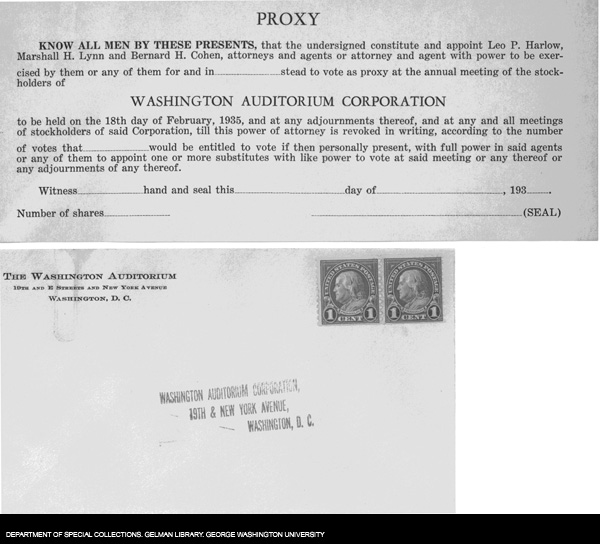Washington Board of Trade: Document View
« previous document | next document »
| Title: | The Washington Auditorium Corporation |
| Author: | The Washington Auditorium Corporation |
| Date: | 1/24/1935 |
Document Information
Bibliographic Metadata
| Author: | The Washington Auditorium Corporation |
| Title: | The Washington Auditorium Corporation |
| Date: | 1/24/1935 |
| Archive: | Special Collections, Gelman Library, George Washington University |
| Collection name: | The Greater Washington Board of Trade |
| Document location: | Box 237, Folder 1, "The Civic Center Project" |
| Publication location: | Washington, D.C. |
| Publisher: |
Descriptive Metadata
| Editorial notes: | |
| Description: | The Washington Auditorium Corporation was founded in January 1922 with the purpose of raising funds through the sale of bonds and public stock for the construction and maintenance of a sizable venue to hold conventions and cultural events to be erected at 19th and E Streets and New York Avenue. The Washington Board of Trade provided leadership in forming this separate entity, complete with its own officers and board of directors. Despite claims of being a financially self-supporting venture that would show a profit, the Auditorium was troubled from the beginning. Stock sales were slow and construction was delayed. As evidenced by these documents, the Auditorium struggled financially after being finished. Hit hard by the Depression, it closed in the late 1930s, and was converted to government office space. With hopes of completing construction by the fall of 1922, the Washington Auditorium Corporation formed with these officers: Colonel Robert N. Harper, president; Albert Schulteis, General Anton Stephen and Thomas Bradley, vice presidents; Charles J. Columbus, secretary; and C. J. Gockeler, treasurer. Yet fundraising and construction delays hit the project, holding off completion of the Auditorium until the late spring of 1924. The facility held over 5,000 patrons with 28,000 square feet of convention space. Early events included the Chicago Opera and an exhibition of industry that included displays of engraving, printing, and gun making. With the system of government imposed on the District in the 1920s, the Auditorium had to be privately funded apart from going through the rigors of Congressional approval. In 1913, a George Washington Memorial Hall to seat 6,000 was proposed by Congress and was actually designed. But the necessary money for construction failed to win approval when it came to a vote in Congress. The failure of Federal approval for the Washington Memorial Hall motivated the private funding of the Washington Auditorium and the founding of the Corporation. But, the Washington Auditorium was destined for financial failure. This communication from the Corporation to shareholders dated January 24, 1935 provides a glimpse into the financial woes. The letter from the president and secretary states the Corporation was behind three months on mortgage payments, but was able to recently meet the payments. Although, the Corporation "cannot, however, say when we will be able to make a further (mortgage) payment." Also, "it is a pleasure to state that we are no longer in arrears in the payment of our taxes." The Auditorium struggled to meet the mortgage and pay taxes owed to the District. The attached statement of income and expenditures also paints a bleak picture. In 1933, the Washington Auditorium Corporation showed a profit of only $189.32. At the end of 1934, only $3,754.77 of cash was in hand. The Auditorium struggled financially throughout the 1930s. The last major event held in the Auditorium was Franklin D. Roosevelt's 1933 Inaugural Ball. Come the end of the decade, the Auditorium became insolvent and declared bankruptcy. With the White House only two blocks away, it became a favorable location for conversion to government office space and remained as such until the building was razed in the 1960s. For its time, the Washington Auditorium served as the largest venue in the District for conventions and cultural events. In 1929, the Daughters of the American Revolution opened the 4,000 seat Constitution Hall on D Street, which still operates to this day. Upon the demise of the Washington Auditorium, the D.A.R. Constitution Hall served as the District's main cultural venue until the John F. Kennedy Center for the Performing Arts opened in September of 1971. |
| Subjects: | the Greater Washington Board of Trade;; urban planning;; Washington, D.C.;; Washington D.C. city government;; The Washington Auditorium Corporation;; city planning |
Technical Metadata
| Date scanned: | 3/13/2006 |
| Person scanning: | Craig Clarke |
| Date converted: | 3/13/2006 |
| Person converting: | Craig Clarke |
| Scanner used: | Fujitsu FI-4220C |
| OCR program: | PixEdit 7 Rev. 7.3.6 |
| Technical notes: |

